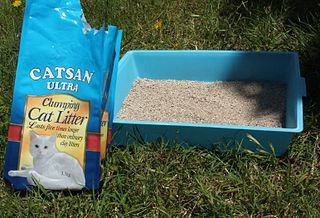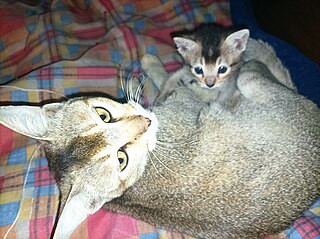
The cat, commonly referred to as the domestic cat or house cat, is the only domesticated species in the family Felidae. Recent advances in archaeology and genetics have shown that the domestication of the cat occurred in the Near East around 7500 BC. It is commonly kept as a house pet and farm cat, but also ranges freely as a feral cat avoiding human contact. It is valued by humans for companionship and its ability to kill vermin. Because of its retractable claws it is adapted to killing small prey like mice and rats. It has a strong flexible body, quick reflexes, sharp teeth, and its night vision and sense of smell are well developed. It is a social species, but a solitary hunter and a crepuscular predator. Cat communication includes vocalizations like meowing, purring, trilling, hissing, growling, and grunting as well as cat body language. It can hear sounds too faint or too high in frequency for human ears, such as those made by small mammals. It also secretes and perceives pheromones.

A kitten is a juvenile cat. After being born, kittens display primary altriciality and are fully dependent on their mothers for survival. They normally do not open their eyes for seven to ten days. After about two weeks, kittens develop quickly and begin to explore the world outside their nest. After a further three to four weeks, they begin to eat solid food and grow baby teeth. Domestic kittens are highly social animals and usually enjoy human companionship.

The Munchkin, also known as Sausage Cat, is a breed of cat characterized by its very short legs, which are caused by genetic mutation. Compared to many other cat breeds, it is a relatively new breed, documented since 1940s and officially recognized in 1991. The Munchkin is considered to be the original breed of dwarf cat.

A litter box, also known as a sandbox, cat box, litter tray, cat pan, potty, pot or litter pan, is an indoor feces and urine collection box for cats, as well as rabbits, ferrets, miniature pigs, small dogs, and other pets that instinctively or through training will make use of such a repository. They are provided for pets that are permitted free roam of a home but who cannot or do not always go outside to excrete their metabolic waste.

Housebreaking or house-training is the process of training a domesticated animal that lives with its human owners in a house or other residence to excrete outdoors, or in a designated indoor area, rather than to follow its instinctive behaviour randomly inside the house.

Clicker training is a positive reinforcement animal training method based on a bridging stimulus in operant conditioning. The system uses conditioned reinforcers, which a trainer can deliver more quickly and more precisely than primary reinforcers such as food. The term "clicker" comes from a small metal cricket noisemaker adapted from a child's toy that the trainer uses to precisely mark the desired behavior. When training a new behavior, the clicker helps the animal to quickly identify the precise behavior that results in the treat. The technique is popular with dog trainers, but can be used for all kinds of domestic and wild animals.

Dog training is a kind of animal training, the application of behavior analysis which uses the environmental events of antecedents and consequences to modify the dog behavior, either for it to assist in specific activities or undertake particular tasks, or for it to participate effectively in contemporary domestic life. While training dogs for specific roles dates back to Roman times at least, the training of dogs to be compatible household pets developed with suburbanization in the 1950s.

Cats need to communicate for a variety of reasons, including to show happiness, to express anger, to solicit attention, and to observe potential prey; cats collaborate, play, and share resources with each other. When they communicate with humans, they do so to get what they need or want, such as food, water, attention, or play.
Aging in cats is the process by which cats change over the course of their natural lifespans. The average lifespan of a domestic cat may range from 10 to 15 years. As cats senesce, they undergo predictable changes in health and behavior. Dental disease and loss of olfaction are common as cats age, affecting eating habits. Arthritis and sarcopenia are also common in older cats. How a cat's health is affected by aging may be managed through modifications in a cat's diet, accessibility adjustments, and cognitive stimulation.

Cat intelligence is the capacity of the domesticated cat to solve problems and adapt to its environment. Research has shown that feline intelligence includes the ability to acquire new behavior that applies knowledge to new situations, communicating needs and desires within a social group and responding to training cues.
Growling is a low, guttural vocalization produced by animals as an aggressive warning but can also be found in other contexts such as playful behaviors or mating. Different animals will use growling in specific contexts as a form of communication. In humans, low or dull rumbling noises may also be emitted when they are discontent with something or they are angry, although this human sound is often termed "groaning".

Cat behavior is a cat's behavior and responses to events and other stimuli. Cat behavior includes body language, elimination habits, aggression, play, communication, hunting, grooming, urine marking, and face rubbing. It varies among individuals, colonies, and breeds.
A cat pheromone is a chemical molecule, or compound, that is used by cats and other felids for communication. These pheromones are produced and detected specifically by the body systems of cats and evoke certain behavioural responses.

Cat play and toys incorporates predatory games of "play aggression". Cats' behaviors when playing are similar to hunting behaviors. These activities allow kittens and younger cats to grow and acquire cognitive and motor skills, and to socialize with other cats. Cat play behavior can be either solitary or social. They can play with a multitude of toys ranging from strings, to small furry toys resembling prey, to plastic bags.

A meow or miaow is a cat vocalization. Meows may have diverse tones in terms of their sound, and what's heard can vary from being chattered to calls, murmurs, and whispers. Adult cats rarely meow to each other. Thus, an adult cat meowing to human beings is generally considered a post-domestication extension of meowing by kittens: a call for attention. Felines usually communicate with each other via their shared sense of smell, yet with people they often make verbal cues around behavior, such as having a specific sound indicate a desire to go outside.

Hundreds of millions of cats are kept as pets around the world.

The Amazing Acro-cats is a circus troupe of domestic cats and a few other small animals, founded by animal trainer Samantha Martin in Chicago, Illinois. One of the featured acts is the musical band, the Rock-Cats. The troupe, based in Griffin, Georgia, tours the United States for much of the year.

Dog-like cat is a term in popular culture that refers to specific breeds of domestic cats that have unusual behavioral tendencies that are reminiscent of young domestic dogs. These are within the scope of feline behavior, and may be enhanced through selective breeding. These behaviors, not specific to any breed, include following people around from room to room, the desire to receive frequent moments of physical affection such as being held and petted, a lack of aggression toward some fellow animals, and a placid nature. Certain owners may successfully attempt to train their cats to perform on command, such as via clicker training, akin to canines and other domesticated animals.
Cat behaviorists are individuals who specialize in working in close environments with not only the cats, but their owners, and dealing with managing the behavior of the cat. A cat behaviorist can be certified or certificated after years of academic study and practical case experience. However, it is also possible for a behaviorist to work locally without completing extensive training.
Feline cognitive dysfunction (FCD) is a cognitive disease prevalent in cats, directly related to the brain aging, leading to changes in awareness, deficits in learning and memory, and decreased responsiveness to stimuli. It is also known as cognitive dysfunction syndrome (CDS). Alzheimer's disease and dementia in humans are diseases with comparable symptoms and pathology.

















